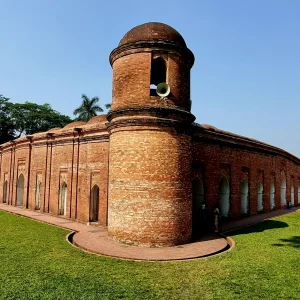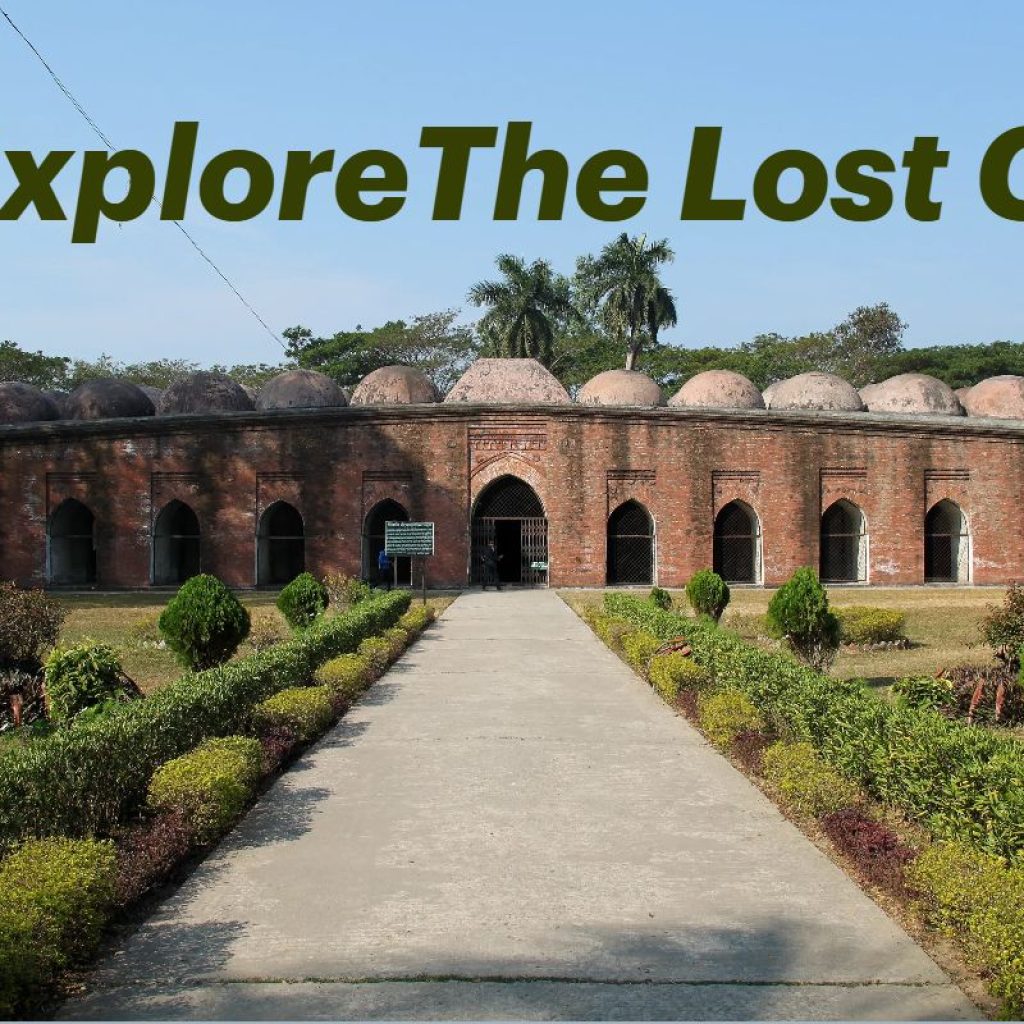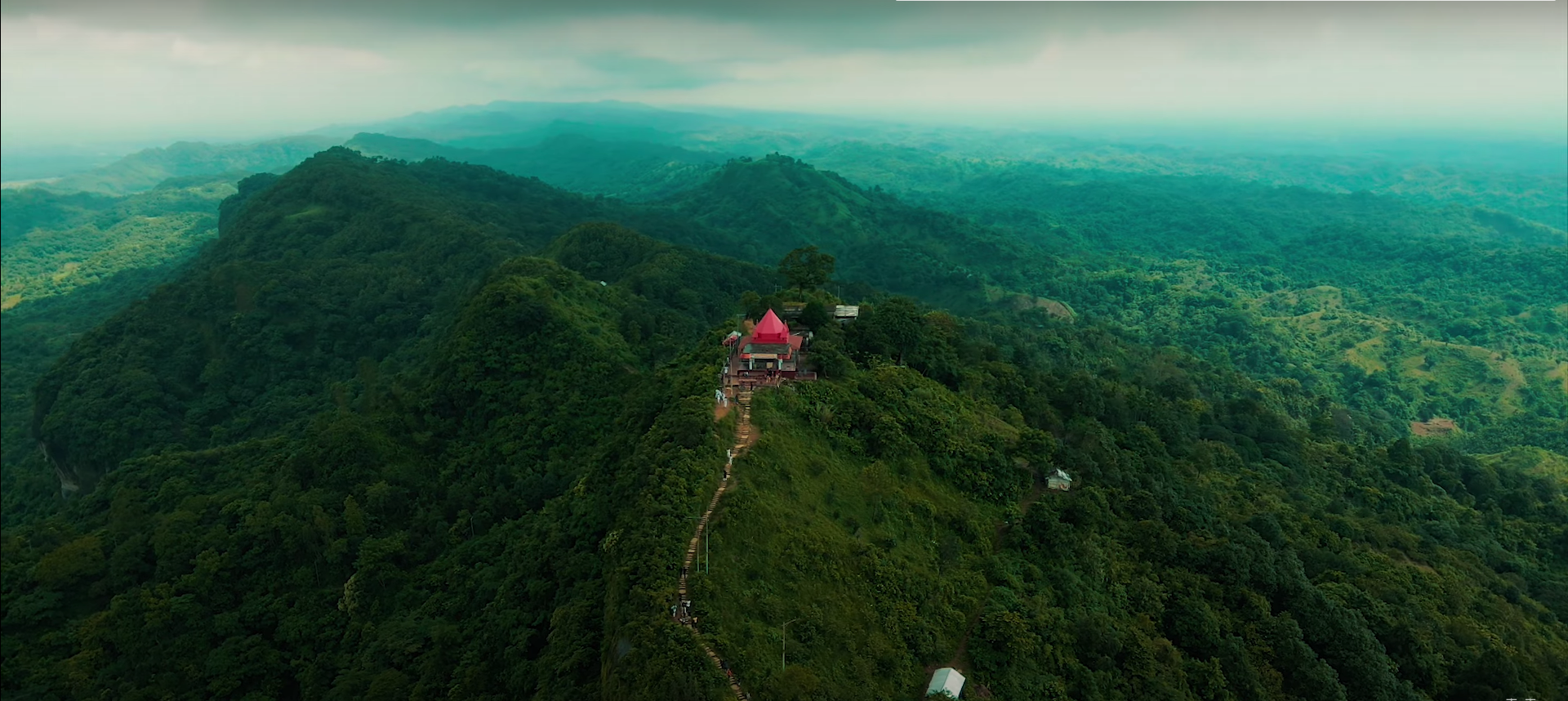
Tucked away in the peaceful town of Bagerhat(‘বাগেরহাট), a historical gem in southern Bangladesh, stands the remarkable Shat Gambuj Mosque. As a UNESCO World Heritage Site, this awe-inspiring structure attracts visitors from across the globe. Also referred to as the “Sixty Dome Mosque,” “Shat Gombuj Mosque,” or “60 Gombuj Mosque,” it reflects the profound historical and cultural heritage of the area. Whether you have a passion for history or simply a love for travel, exploring the Shat Gambuj Mosque in Bagerhat promises an experience to remember.
Bagerhat, also referred to as the “City of Mosques,” is a historic district in the Khulna Division of Bangladesh. Originally known as Khalifatabad, this ancient city was established in the 15th century by the revered Muslim saint and general, Khan Jahan Ali. He envisioned a bustling Islamic metropolis, replete with grand mosques, reservoirs, and civic structures. The Shat Gambuj Mosque, built during his tenure, stands as the crown jewel of Bagerhat’s architectural legacy.
Historical Background of Shat Gombuj Mosque:
The Shat Gambuj Mosque, also known as the Sixty Dome Mosque, was built during the mid-15th century by Khan Jahan Ali, a revered saint and a celebrated ruler of the Bengal Sultanate. Khan Jahan Ali, known for his administrative skills and contributions to the spread of Islam, established the city of Khalifatabad, now known as Bagerhat. This planned city was a hub of Islamic culture, architecture, and education. Among the many architectural marvels he constructed, the Shat Gambuj Mosque remains the most iconic.
 The construction of the mosque commenced in 1442 and was finished by 1459. Its name, “Shat Gambuj,” translates to “Sixty Domes,” though the mosque actually features seventy-seven domes supported by a network of arches and columns. This discrepancy in the name and actual structure is a point of intrigue for historians and scholars.
The construction of the mosque commenced in 1442 and was finished by 1459. Its name, “Shat Gambuj,” translates to “Sixty Domes,” though the mosque actually features seventy-seven domes supported by a network of arches and columns. This discrepancy in the name and actual structure is a point of intrigue for historians and scholars.
Why It is called Lost City:
Bagerhat is called the “Lost City” because it carries an air of mystery and forgotten grandeur. Once a bustling medieval town founded in the 15th century by the visionary leader Khan Jahan Ali, it was filled with life, spirituality, and trade. The city was adorned with stunning mosques, serene reservoirs, and impressive infrastructure that reflected its importance. But as time passed, natural disasters and shifting trade routes caused the city to fade away. Slowly, the vibrant community disappeared, and the lush forests reclaimed the land, hiding its treasures for centuries. When its breathtaking architecture, like the Shat Gombuj Mosque, was rediscovered, it felt like uncovering a piece of history that had been quietly waiting to tell its story.
Exploring the Mosque City of Bagerhat:
Bagerhat, or “Bagerhat Zila” as it is locally known, is a treasure chest of historical and cultural sites. Here are some must-visit attractions in and around the Shat Gambuj Mosque:
1. Khan Jahan Ali’s Mausoleum
Located near the Shat Gambuj Mosque, this tomb commemorates the life and legacy of Khan Jahan Ali. The mausoleum’s modest yet graceful design symbolizes his humility and dedication.
2. Ghora Dighi
This massive reservoir, situated close to the 60 Gombuj Mosque, was built to ensure a steady water supply for the residents of Khalifatabad. The name “Ghora Dighi,” meaning “Horse Pond,” stems from a local legend involving Khan Jahan Ali’s horse.
3. Nine Dome Mosque
Another architectural gem in Bagerhat, the Nine Dome Mosque showcases exquisite terracotta decorations and offers a glimpse into the evolution of mosque architecture in the region.
4. Chunakhola Mosque
Smaller in scale but equally captivating, the Chunakhola Mosque is a hidden gem in the Mosque City of Bagerhat. Its intricate patterns and serene setting make it worth a visit.
Architectural Features:
Layout and Design
The Shat Gambuj Mosque is rectangular, measuring approximately 49 meters in length and 33 meters in width. Its layout is divided into seven longitudinal aisles and eleven transverse sections, creating a grid-like interior supported by 60 stone pillars. These pillars form the backbone of the structure, supporting the iconic domes that give the mosque its name.
Domes and Arches
The mosque’s roof features seventy-seven domes, including seventy small domes arranged in rows and seven larger domes in the central aisle. The domes are hemispherical and rest on an intricate network of arches, showcasing the architectural influence of Tughlaq and Sultanate styles. The arches are pointed, a hallmark of Islamic architecture, and are adorned with terracotta embellishments.
Materials and Techniques
The mosque was constructed using locally sourced bricks and terracotta, with stone pillars imported from elsewhere in Bengal. The walls are thick and sturdy, designed to withstand the test of time and the region’s tropical climate. The use of terracotta panels for decorative purposes adds an artistic touch, with motifs of flowers, geometric patterns, and Arabic calligraphy.
Prayer Hall
The prayer hall is a peaceful area designed to hold a significant number of worshippers. It features a mihrab, a semicircular niche in the wall that indicates the direction of Mecca. The mihrab is intricately decorated with terracotta patterns, showcasing the artistic prowess of the craftsmen of the time.
Cultural and Religious Significance:
A Center for Islamic Learning
During Khan Jahan Ali’s rule, the mosque was not merely a place of worship but also a center for Islamic learning and community gatherings. It attracted scholars, theologians, and students from across the region, contributing to the spread of Islamic education and culture.
Pilgrimage Site
Even today, the Shat Gambuj Mosque holds immense religious significance. It is a popular site for pilgrims who come to pay their respects to Khan Jahan Ali, whose mausoleum is located nearby. The annual Urs festival, commemorating the saint’s death anniversary, attracts thousands of devotees.
Activities for Tourists:
Whether you’re a history buff or a casual traveler, Bagerhat offers a range of activities:
- Photography: Capture the stunning details of the Shat Gambuj Mosque and other historical landmarks.
- Cultural Exploration: Learn about the lifestyle and traditions of the local community in Bagerhat Zila.
- Relaxation: Unwind by the serene waters of Ghora Dighi or the nearby rivers that crisscross the region.
The Shat Gambuj Mosque in Modern Times:
A Tourist Destination
The mosque is one of Bangladesh’s most visited historical sites, attracting both domestic and international tourists. Guided tours provide visitors with insights into its history, architecture, and cultural significance.
Educational Value
The site serves as a valuable resource for historians, archaeologists, and architecture students. Its unique features offer lessons in Islamic architecture and the history of Bengal.
Symbol of Heritage
The Shat Gambuj Mosque is more than just a historical monument; it is a symbol of Bangladesh’s rich cultural and religious heritage. It stands as a reminder of the region’s glorious past and the enduring legacy of Khan Jahan Ali.
Travel Tips for Visiting Bagerhat:
- Best Time to Visit: The cooler months between November and February are ideal for exploring Bagerhat Zila.
- Local Cuisine: Don’t miss out on trying traditional Bangladeshi dishes, including fish curry and pithas (sweet rice cakes).
- Guided Tours: Consider hiring a local guide to gain deeper insights into the history and significance of the Shat Gambuj Mosque and other sites.
- Respect Local Customs: Honor local traditions by dressing conservatively and taking off your shoes before entering the mosque.
Conclusion:
The Shat Gambuj Mosque in Bagerhat is more than just a tourist attraction; it’s a journey into the heart of Bangladesh’s history and culture. As one of the top sightseeing places in Bangladesh, this magnificent mosque offers a unique blend of architectural splendor and historical intrigue. Whether you’re discovering the “City of Mosques” or uncovering the history of Khalifatabad, a trip to the Shat Gambuj Mosque is certain to leave you feeling enlightened and inspired. So, pack your bags and embark on a “Bangladesh UNESCO World Heritage Tour” to uncover the timeless beauty of Bagerhat.
For those planning a trip to explore this cultural gem, a Bangladesh travel company can help craft the perfect itinerary, ensuring you experience all the wonders Bagerhat has to offer. Working with a reputable travel agency BD will allow you to make the most of your visit, providing expert guidance and seamless travel arrangements for an unforgettable journey.






